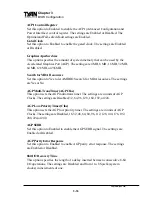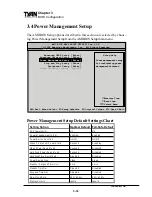
http://www.tyan.com
3-20
Chapter 3
BIOS Configuration
specified period of display inactivity has expired. The settings are Off, Stand
By, or Suspend.
Video Power Down Mode
This option specifies the power state that the video subsystem enters when
AMIBIOS places it in a power saving state after the specified period of display
inactivity has expired. The settings are Stand By, Suspend, or Disabled.
Hard Disk Power Down Mode
This option specifies the power conserving state that the hard disk drive
enters after the specified period of hard drive inactivity has expired. The
settings are Disabled, Stand By, or Suspend.
Hard Disk Time Out (Minute)
This option specifies the length of a period of hard disk drive inactivity. When
this length of time expires, the computer enters power-conserving state
specified in the Hard Disk Power Down Mode option (see the previous page).
The settings are Disabled, and from 1 to 15 minutes, in one minute intervals.
Power Saving Type
There are several types of sleeping states within the general sleep state. This
option allows you to choose how “asleep” you want your system to be. In
deeper sleep modes, more energy is saved. However, upon waking up, the
system must “reorient” itself, and reestablish control over the system’s
sleeping components. The settings are POS, Sleep, Stop Clock, and Deep
Sleep. POS is the lightest sleep mode; Deep Sleep is the heaviest.
Standby/Suspend Timer Unit
This option specifies the unit of time used for the Standby and Suspend time
out periods. The settings are 4 msec, 4 sec, 32 sec, or 4 min.
Standby Time Out
This option defines the length of time that the system, while in Full On state,
must be inactive before it enters Standby mode. The settings are Disabled and
from 4 minutes to 508 minutes, in increments of 4 minutes.
Suspend Time Out
This option defines the length of time that the system, while in Standby mode,
must be inactive before it enters Suspend mode. The settings are Disabled and
from 4 minutes to 508 minutes, in increments of 4 minutes.
















































